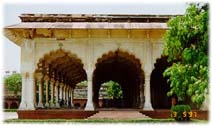|
Agra's history goes back more than 2500
years, but the it wasn't until the reign of the Mughals that
Agra became more than a provincial city. Humayun, son of the
founder of the Mogul empire, was offered jewelry and precious
stones by the family of the Raja of Gwalior,
 one
of them the famous Koh-i-Noor. The heydays of Agra came with the
reign of Humayun's son, Akbar The Great. During his reign, the
main part of the Agra fort was built. Construction of the fort
started in 1156 and was finished in 1605. Shah Jahan, who built
the Taj
Mahal, erected most of the buildings inside the fortress. one
of them the famous Koh-i-Noor. The heydays of Agra came with the
reign of Humayun's son, Akbar The Great. During his reign, the
main part of the Agra fort was built. Construction of the fort
started in 1156 and was finished in 1605. Shah Jahan, who built
the Taj
Mahal, erected most of the buildings inside the fortress.
The fort is built alongside the Yamuna river and stretches
almost 2.5 km. It consists of a wall built in red sandstone and
several buildings inside. The wall has 2 gates, the Delhi Gate
and the Amar Singh Gate. You can only enter the fort via the
Amar Singh Gate. Part of the fort is still in use by the Indian
Army and are not accessible to the public, but there's still
enough left to get an insight on the way the Mughals lived in
the 16th century.
After going through the Amar Singh Gate you walk over a ramp and
enter the Great Courtyard. On the right hand sight, there's the
many pillared Diwan-i-Am (Hall of Public Audience).
 It
was built by Shah Janan in 1628. Furthermore you find the Royal
Pavilions. It contains beautiful mosques (Nagina Masjid & Mina
Masjid), palaces (Macchi Bhavan, Khas Mahal, Shish Mahal, Shah
Jahani Mahal) and the Zenana Mina Bazaar. Several of the
buildings are made of pure marble with beautiful carvings. To
cool off the rooms in the marble pavilions, the walls were
hollow and filled with running water. From the balconies in the
pavilions, you have a nice view on the Yamuna river and the
Taj
Mahal. It
was built by Shah Janan in 1628. Furthermore you find the Royal
Pavilions. It contains beautiful mosques (Nagina Masjid & Mina
Masjid), palaces (Macchi Bhavan, Khas Mahal, Shish Mahal, Shah
Jahani Mahal) and the Zenana Mina Bazaar. Several of the
buildings are made of pure marble with beautiful carvings. To
cool off the rooms in the marble pavilions, the walls were
hollow and filled with running water. From the balconies in the
pavilions, you have a nice view on the Yamuna river and the
Taj
Mahal.
As a matter of fact, the emperor Shah Jahan, who built the Taj,
was imprisoned by his son Aurangzeb in the Agra Fort where he
had a view on the building erected for his deceased wife. Shah
Jahan is said to have died in the Musamman Burj, a tower with a
beautiful marble balcony. From there you probably have the best
view on the Taj. Between the many pavilions, you find small well
maintained gardens.
|